
Fire Alarm
FIRE ALARM CONTROL PANEL (FACP) A Fire Alarm Control Panel (FACP), or Fire Alarm Control Unit (FACU), is the controlling component of a Fire Alarm System. The panel receives information from environmental sensors designed to detect changes associated with fire, monitors their operational integrity and provides for automatic control of equipment, and transmission of information necessary to prepare the facility for fire based on a predetermined sequence
Where Fire alarm control panel should be located?
The Fire Alarm Control panel should normally be sited in an area as follows: Preferably in an area of low fire risk and on the ground floor by the entrance used by the Fire Brigade and preferably viewable from outside of the building. It should be located in an area common to all building users and where automatic detection is in use, the Control Panel should be in a protected area.
All Fire Alarm Systems essentially operate on the same principle. If a detector detects smoke or heat, or someone operates a break glass unit, then alarm sounders operate to warn others in the building that there may be a fire and to evacuate
Conventional
Panels 2, 4, 8, 16 up to 128 Zones
Benefits of Conventional Fire Alarms
Conventional fire alarms can be set up in zones, with each zone hardwired to a control panel or zone expander. Conventional fire alarm systems are much less expensive and require significantly less labor to install, but sometimes it can be challenging locating the alarms.
To put it simple, if a conventional fire alarm detects a fire, it may tell you the zone/ area of the fire but not the exact location of the fire. There's no design where a specific fire alarm can signal exactly where the fire is occurring.
Addressable
4 Loop Panel
Benefits of Addressable Fire Alarms
• Different devices having different alarm thresholds based on their location
• An enunciator panel in the front of your building to show exactly which devices or zones are alarming
• Scalable networks that allow you to add zones with ease
• Addressable fire alarm systems are typically expensive than conventional alarms, but the extra information they provide to firefighters and building managers is invaluable
• Another benefit of addressable fire alarms is that they require less cabling than conventional fie alarms
All of the devices installed as part of an addressable fire alarm systems connect to a single cabling loop that runs through the entire premises making it easy to add new devices to existing system
Detectors
Smoke Detector
Most smoke detectors work either by optical detection (photoelectric) or by physical process (ionization), while others use both detection methods
to increase sensitivity to smoke.
• Smoke detectors are typically housed in a disk-shaped plastic enclosure about 150 millimeters (6 in) in diameter and 25 millimeters (1 in) thick,
• A smoke detector is a device that detects smoke, typically as an indicator of fire.

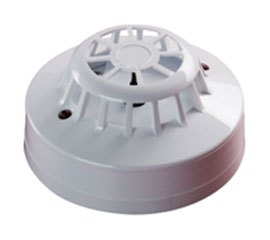
Heat Detector
• A heat detector is a fire alarm device designed to respond
• when the converted thermal energy of a fire increases the temperature of a heat sensitive
element. The thermal mass and conductivity of the element regulate the rate flow of heat
into the element. All heat detectors have this thermal lag. Heat detectors have two main
classifications of operation, "rate-of-rise" and "fixed temperature."
Multi Detector
Multi sensor detectors combine multiple detection signals that a fire has started, such as the levels of heat and ionization, as opposed to specializing in only one. In order to detect a fire in the quickest possible amount of time, an alarm sensor has to detect the products of combustion from a particular type of fire.
However, one detector might be great at picking up smoke particles from a synthetic materials fire for example, but not work well at detecting the heat from a rapidly progressing liquids fire. The advantage of multi sensor detectors is that they quickly sense when different types of fires have started. Multi sensor detectors are normally triggered by many more types of fires than single sensor detectors.
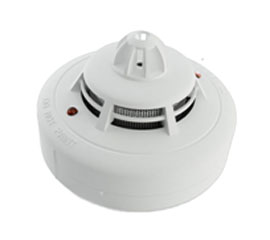
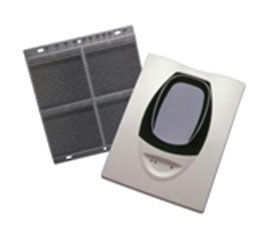
Beam Detector
They are used to detect fires in buildings where standard point smoke detectors would either be uneconomical or restricted for use by the height of the building are often installed in warehouses as a cost effective means of protecting large open spaces.
Notification appliances:
This component also known as hooters and sounders uses energy supplied from the fire alarm system or other stored energy source, to inform the proximate persons of the need to take action, usually to evacuate. This is done by means of a flashing light, strobe light, electromechanical horn, "beeper horn", chime, bell, speaker, or a combination of these devices.

M.C.P
Manual fire alarm activation is typically achieved through the use of a pull station (USA & Canada) or call point (Europe, Australia, Asia and Germany), which then sounds the evacuation alarm for the relevant building or zone. Manual fire alarm activation requires human intervention, as distinct from automatic fire alarm activation such as that provided through the use of heat detectors and smoke detectors. It is, however, possible for call points/pull stations to be used in conjunction with automatic detection as part of an overall fire detection and alarm system. Systems in completed buildings tend to be wired in and to include a control panel.
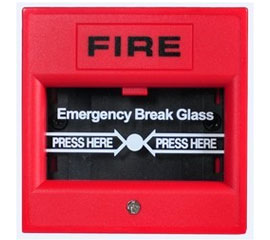
Response Indicator
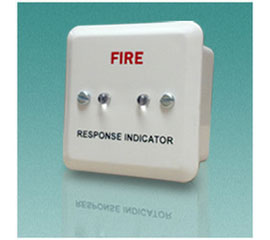
Response indicators are used as an auxiliary indication for detectors that are located in closed spaces (i. E, not visible. For example: above false ceilings, in closed rooms, etc). Detectors are equipped with a terminal to allow connection to the response indicator. Response indicators contain a led which lights up as soon as the connected detector detects fire.
